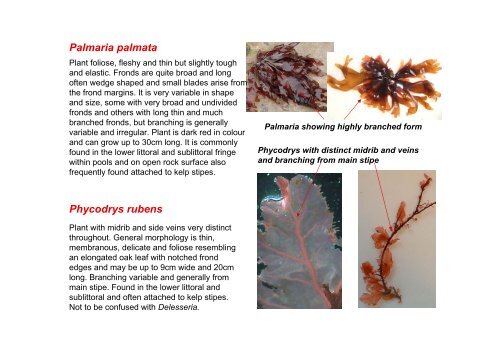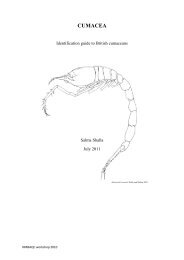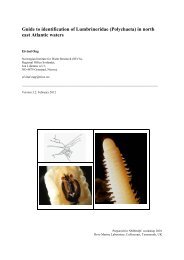s A Field Guide to the British Seaweeds - NMBAQC
s A Field Guide to the British Seaweeds - NMBAQC
s A Field Guide to the British Seaweeds - NMBAQC
You also want an ePaper? Increase the reach of your titles
YUMPU automatically turns print PDFs into web optimized ePapers that Google loves.
Palmaria palmata<br />
Plant foliose, fleshy and thin but slightly <strong>to</strong>ugh<br />
and elastic. Fronds are quite broad and long<br />
often wedge shaped and small blades arise from<br />
<strong>the</strong> frond margins. It is very variable in shape<br />
and size, some with very broad and undivided<br />
fronds and o<strong>the</strong>rs with long thin and much<br />
branched fronds, but branching is generally<br />
variable and irregular. Plant is dark red in colour<br />
and can grow up <strong>to</strong> 30cm long. It is commonly<br />
found in <strong>the</strong> lower lit<strong>to</strong>ral and sublit<strong>to</strong>ral fringe<br />
within pools and on open rock surface also<br />
frequently found attached <strong>to</strong> kelp stipes.<br />
Phycodrys rubens<br />
Plant with midrib and side veins very distinct<br />
throughout. General morphology is thin,<br />
membranous, delicate and foliose resembling<br />
an elongated oak leaf with notched frond<br />
edges and may be up <strong>to</strong> 9cm wide and 20cm<br />
long. Branching variable and generally from<br />
main stipe. Found in <strong>the</strong> lower lit<strong>to</strong>ral and<br />
sublit<strong>to</strong>ral and often attached <strong>to</strong> kelp stipes.<br />
Not <strong>to</strong> be confused with Delesseria.<br />
Palmaria showing highly branched form<br />
Phycodrys with distinct midrib and veins<br />
and branching from main stipe




